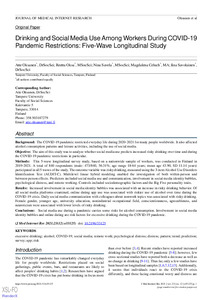Drinking and Social Media Use among Workers during COVID-19 Pandemic Restrictions : Five-Wave Longitudinal Study
Oksanen, Atte; Oksa, Reetta; Savela, Nina; Celuch, Magdalena; Savolainen, Iina (2021-12)
Oksanen, Atte
Oksa, Reetta
Savela, Nina
Celuch, Magdalena
Savolainen, Iina
12 / 2021
e33125
Julkaisun pysyvä osoite on
https://urn.fi/URN:NBN:fi:tuni-202112219446
https://urn.fi/URN:NBN:fi:tuni-202112219446
Kuvaus
Peer reviewed
Tiivistelmä
Background: The COVID-19 pandemic restricted everyday life during 2020-2021 for many people worldwide. It also affected alcohol consumption patterns and leisure activities, including the use of social media. Objective: The aim of this study was to analyze whether social media use predicts increased risky drinking over time and during the COVID-19 pandemic restrictions in particular. Methods: This 5-wave longitudinal survey study, based on a nationwide sample of workers, was conducted in Finland in 2019-2021. A total of 840 respondents (male: 473/840, 56.31%; age range 18-64 years; mean age 43.90, SD 11.14 years) participated in all 5 waves of the study. The outcome variable was risky drinking, measured using the 3-item Alcohol Use Disorders Identification Test (AUDIT-C). Multilevel linear hybrid modeling enabled the investigation of both within-person and between-person effects. Predictors included social media use and communication, involvement in social media identity bubbles, psychological distress, and remote working. Controls included sociodemographic factors and the Big Five personality traits. Results: Increased involvement in social media identity bubbles was associated with an increase in risky drinking behavior. Of all social media platforms examined, online dating app use was associated with riskier use of alcohol over time during the COVID-19 crisis. Daily social media communication with colleagues about nonwork topics was associated with risky drinking. Female gender, younger age, university education, nonindustrial occupational field, conscientiousness, agreeableness, and neuroticism were associated with lower levels of risky drinking. Conclusions: Social media use during a pandemic carries some risks for alcohol consumption. Involvement in social media identity bubbles and online dating are risk factors for excessive drinking during the COVID-19 pandemic.
Kokoelmat
- TUNICRIS-julkaisut [16929]
